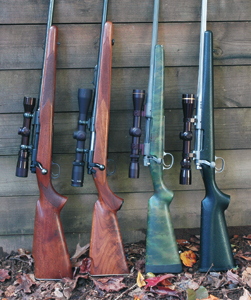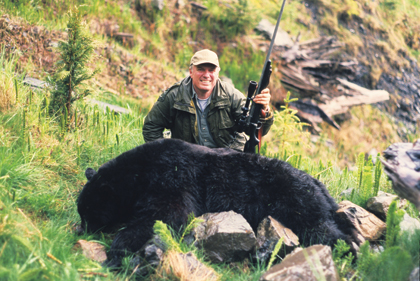September 23, 2010
By Layne Simpson
By Layne Simpson
 Before super-lightweight rifles such as the Rifles Inc. StratoStainless and PGW Model 15 Ti came along, the Winchester Model 70 Featherweight and Remington Model 725 at about 8.5 pounds with scopes were considered by most hunters to be light rifles. |
I showed up in a hunting camp with a rifle wearing a fiberglass stock long before most hunters had ever seen one, and believe me when I say I took a bit of ribbing from my fellow citizens. One described it as the ugliest thing he had ever seen, and I did not argue his opinion since it was the ugliest thing I had ever seen as well. It also felt as cold and lifeless as a witch's heart in my hands, but as I went on to prove to myself on that hunt and others that followed, a top-quality synthetic stock is capable of shrugging off just about anything thrown at it in the field, including a horse's attempt to break it into small pieces.
The synthetic stock and other developments have drastically changed the face of hunting and the equipment carried in the 50 years since the ink dried on the first issue of a new tabloid called Shooting Times exactly five decades ago. Here are what I consider to be the more revolutionary developments in the world of rifles.
Advertisement
The Really Good Factory Trigger
There was a time when the triggers on most bolt-action rifles needed to be fine-tuned by a good gunsmith or totally replaced by an aftermarket unit. It was not something that had to be done, and most hunters managed to get by with those worn by factory rifles, but in many cases there was plenty of room for improvement. The first big step in trigger refinement came in 1948, with the introduction of the Model 721/722 rifles from Remington. It was not perfect, but it was a very long way down the road from what had been available. Later in 1962, a slightly modified version of that same trigger appeared on Remington's new Model 700, and for decades thereafter it served as the benchmark by which all other factory triggers were judged. But to be as good as that trigger was capable of, it still required the gentle touch of a talented gunsmith.
Today, some factory rifles come with triggers as good as those we used to pay gunsmiths to install. The X-Mark Pro from Remington, the AccuTrigger from Savage, and the Feather trigger of the Browning X-Bolt are examples. And just as factory rifle triggers have gotten better so have aftermarket triggers, with the Jewell most often seen on high-grade rifles of today.
Advertisement
The Half-Inch Big-Game Rifle
Fifty years ago a heavy-barrel varmint rifle capable of shooting its bullets inside an inch was dreamed of by many but owned by only a few. We now have big-game rifles light enough to tote into the clouds in pursuit of sheep and other mountain game that are more accurate than the typical varmint rifle of yesteryear. And not just in wimp calibers either. Through the years I have worked with such rifles, in calibers ranging up to .416 Remington Magnum, that are capable of keeping three bullets inside half an inch far longer than I cared to shoot them from the bench.
About 30 years ago a South Carolina farmer who happened to also be both machinist and serious rifle competitor started building hunting rifles, incorporating the same materials, techniques, and standards used to build benchrest rifles capable of consistently keeping five bullets inside 1/4 inch at 100 yards. A few others who are capable of building incredibly accurate big-game rifles have since joined Jarrett. And don't think for one moment that tiny groups come only with synthetic and stainless steel. My two Cooper rifles in .25-06 and 6.5-284 Norma average half an inch and less with their favorite loads, and both are made of old-fashioned (but extremely handsome) walnut and blued steel.
 One of the many favorite big-game rifles the author has enjoyed hunting with during the past 50 years is this one in 6.5 STW built by Rifles Inc. |
Truth be told, we really don't have to have such high levels of accuracy in order to harvest a supply of venison each year, but few will argue the fact that a super-accurate rifle instills confidence, and the more confident a hunter is in his rifle, the more likely he is to shoot it accurately in the field. I know this to be true from personal experience.
The Flyweight Hunting Rifle
There was a time when it was not unusual for a big-game rifle wearing a scope to weigh upwards of 10 pounds. The Remington Model 725 and Winchester Model 70 Featherweight were manufacturers' first serious attempts to reduce the hunter's load, but even they usually tipped the scale at over 8 pounds when equipped for the field.
Through the years a few gunsmiths managed to figure out ways to lighten the weight, but an uncommonly light off-the-shelf rifle did not appear until 1985 when Melvin Forbes introduced a scaled-down version of the Remington Model 700 called the Model 20. Its name comes from the 20-ounce weight of its action, and the entire rifle can be kept at about 6.5 pounds when equipped with accessories of reasonable weight.
Then came the titanium receiver, and a full-sized rifle of the same weight became reality. My Model 15 Ti from Prairie Gun Works weighs about the same as the Ultra Light Model 20, and while my Browning A-Bolt Mountain Ti hefts a few ounces more, it still carries like a feather at the end of a long day.
There are still gunsmiths like Texan Lex Webernick of Rifles Inc. who craft lightweight rifles on the lightened Remington 700 action. I have a matching trio of his rifles in .257 STW, 6.5 STW, and 7mm STW. Fresh from their boxes, each weighed only slightly more than 5 pounds, and those he builds on the titanium Model 700 action weigh even less.
The Synthetic Stock
Back in those days when I first showed up in camp with the synthetic stock and took such a ribbing, they had been around for a while in benchrest competition, but mine was one of the very first to be built specifically for a hunting rifle. As we now know, the idea was too good to die, and that, along with its eventual acceptance by the hunting majority, made it one of the great success stories in the evolution of the hunting rifle. In 1983 Weatherby became the first major company to offer synthetic (on the Mark V FiberMark), and three years later Remington answered with its Model 700 KS Mountain Rifle. Before long other manufacturers began to gingerly step aboard the bandwagon, and now everybody who is anybody offers one or more models. Weatherby continues to sell about equal numbers of walnut and synthetic stocks, but the latter is the better seller at some of the other rifle companies.
I continue to hunt with wood because, to me, how a rifle looks is as important as how accurately it shoots, but anytime the weather promises to be nasty I'm not a bit bashful about turning up in any hunting camp carrying synthetic on my shoulder. And when I do, not a single person comments on the ugly rifle I am using, perhaps because they are also usually carrying one.
 In the beginning, synthetic stocks came in either brown or black, but they are now available in about any color a hunter might want. |
Stainless Steel
The introduction of the synthetic stock made the hunting rifle more durable, but it took the addition of the stainless-steel barreled action to make it virtually weatherproof. In years past both Winchester and Remington had built rifles with barrels of stainless steel, but they went to great lengths to color them to match the receiver since hunters in those days were as likely to be seen in the woods without their pants as with anything other than blued steel. Considering how widely accepted the stainless-steel barreled action is today, one might assume it grew in popularity right alongside the synthetic stock, but such was not the case. When I hunted with an Alpha Alaskan in .284 Winchester in 1986, it was the first all-stainless rifle I had seen. Then came the Browning A-Bolt Stainless Stalker in 1987, and the rust-resistant rifle race was on among the major manufacturers. Today, all companies — both large and small — offer them in about every chambering you can think of, and hunters buy them by the truckloads.
The Incredibly Accurate Semiautomatic
Semiautomatic rifles introduced during the early years of the 20th century were better known for firepower than accuracy, but that began to change in the 1940s when U.S. Army armorers developed ways of fine-tuning the M1 Garand for competitive shooting. In doing so they accomplished what many bolt gun advocates thought impossible, by elevating its accuracy to the same level as that of the match-grade 1903 Springfield. The military accuracy program continued with the replacement of the Garand by the M-14 in 1957 and with the official adoption of the M16 in 1969. When Colt started producing a semiautomatic-only version of the M16 called the AR-15, small private-sector shops came up with methods for making it even more accurate, and the result is a rifle that shoots far more accurately than its appearance might indicate.
Today's autoloading rifles, such as the AR-15 from Les Baer and the M1A Super Match from Springfield Armory, are so accurate you have to actually try one to believe it. I have one of each, and both are capable of consistently shooting five bullets inside an inch, with no small number of groups measuring half an inch and less.
You don't have to shoot a centerfire rifle to enjoy incredible accuracy from a semiautomatic. The .22- caliber Ruger 10/22 Target in my battery will keep its bullets inside half an inch at 50 yards, and my Volquartsen rifle in .17 HMR will do the same at twice that distance. Yes indeed, we have come a very long way in semiautomatic accuracy during the past 50 years.
Hornady LEVERevolution Ammo & The Marlin 336
I don't mean to steal another writer's thunder by mentioning ammunition in a story about rifles, but the Hornady LEVERevolution ammo would not likely have happened without the Marlin rifle, so I just had to include it here. Even though the Model 336 was introduced long before the beginning of Shooting Times, it became a whole new rifle with the introduction of the Hornady ammunition. There was a time when it and other tube-fed hammer guns were considered 200-yard deer rifles at best, mainly because the blunt-nosed bullets they required shed velocity much more quickly than those of more streamlined shape.
Then came Hornady with a tube-magazine-safe pointed bullet to breathe another nine lives into one of America's favorite deer rifles. Seemingly overnight, a rifle of 19th-century design was capable of shooting as flat and as accurately and hitting just as hard as many of today's bolt-action rifles. It could not have happened to a better rifle.
